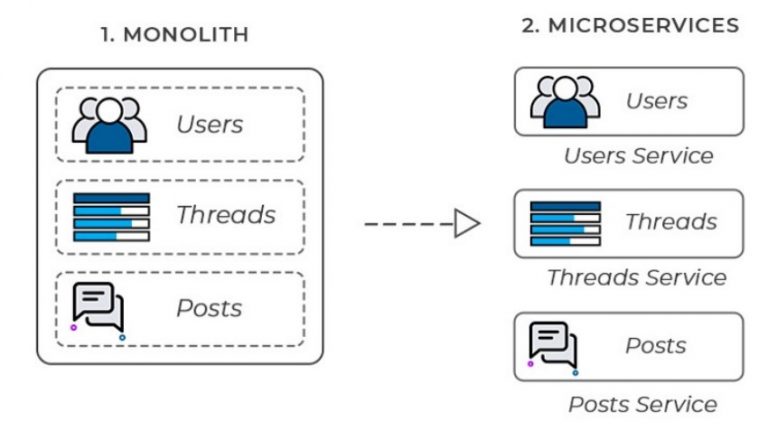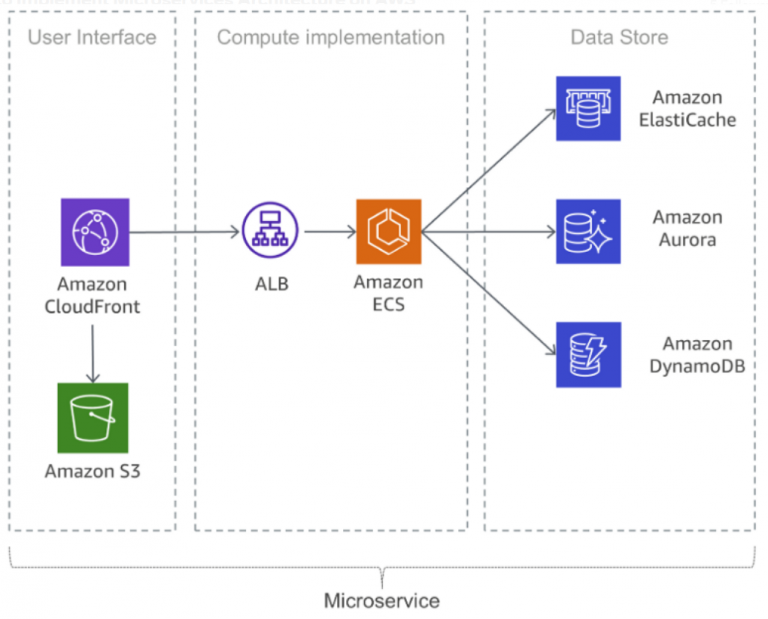The What, Why, and How of Implementing Microservices Architecture on AWS

When it comes to scaling up, things may be complicated when the product architecture isn’t made to be scalable. This is often the scenario with monolith applications. In such a situation, there are two roads before you bring in additional resources and scale vertically by spending a lot of money or restructure your application with the help of microservices and scale horizontally which is cost-effective too. It’s always smarter to choose the second road implementing microservices architecture on AWS.
What are Microservices?
Microservices is an architectural design to build a distributed application using containers. As the name suggests, each function of the application runs as an independent service. This architecture enables each service to update or scale without disrupting the application’s other services. Communication among microservices takes place over well-defined APIs. A microservices framework helps to create a highly distributed and scalable system, which prevents the bottlenecks of a central database as well as boosts business capabilities, like allowing continuous deployment/delivery of applications and modernizing technology stack.
Each microservice can be built, scaled, updated, and managed separately that exponentially boosts the innovation speed, and the simplicity and cost-efficiency of infrastructure management, as compared to development of monolithic apps.
Microservice architectures make applications faster to develop and easier to scale, accelerating the time-to-market and facilitating innovation.
The microservices architecture started to draw attention after several success stories were presented by companies like Amazon, Gilt.com, and Netflix. However, all these companies as well as many other microservice successes had one thing in common — they all were from companies that originated on the web, and that were building new applications, or that had no significant legacy code base to replace.
Traditionally, applications were developed as monolithic software pieces. The addition of new features requires updating and reconfiguring everything from security in the application to communications and process.
Monolithic vs. Microservices Architecture

In monolithic architectures, the processes are tightly coupled and operate in the form of a single service. This implies that if one process in the application faces an increase in demand, the whole architecture needs to be scaled. Improving or adding the features of a monolithic application becomes more complex with the expansion of the code base. This complexity restricts experimentation and increases the difficulty in implementing new ideas. Application availability involves risk with monolithic architectures as several tightly coupled and dependent processes heighten the impact of failure of a single process.
In a microservices architecture, each application is developed as independent components, which run every application process as a service. These services interact over a well-defined interface with the help of lightweight APIs. Each service has a single function to perform and the services are designed for business capabilities. As the services run independently, each service can be deployed, updated, and scaled for meeting demand for certain functions of an application.
Characteristics of Microservices
– Specialized
Each service is built for a group of capabilities and is focused on addressing a specific issue. Over time, if developers add more code to a service, increasing the complexity of the service, it can be split into smaller services.
– Autonomous
In an AWS microservices architecture, each component service can be built, scaled, operated, and deployed without influencing how the other services function. The code or implementation of any service doesn’t need to be shared with any other service. Communication within individual components occurs through well-defined APIs.
Why Go for Implementing Microservices Architecture on AWS?
– Agility
Microservices encourage the functioning of small, independent teams taking ownership of their services. These teams work within a small, well-understood context, as well as can work faster and more independently.
– Easy Deployment
Microservices facilitate continuous delivery and continuous integration. This makes it easier to experiment with new ideas as well as roll back in case something goes wrong. Failure is associated with low costs, which fosters experimentation, simplifies updating of code, and speeds up time-to-market.
– Flexible Scaling
With microservices, each service can be scaled independently to meet demands for the features of the application it supports. This allows teams to right-size the infrastructure needs, measure feature costs accurately, and maintain availability in case there’s a demand spike for a service.
– Resilience
The independence of services heightens the resistance of services to failure. In the case of a monolithic architecture, the failure of a single component can lead to the failure of the whole application. By implementing microservices architecture on AWS, you can get applications to handle complete failure of service by degrading functionality, instead of crashing the full application.
– Reusable Code
Splitting software into well-defined, small modules allows teams to employ functions for different purposes. A service created for a particular function can be utilized as a building block for developing another feature. This enables applications to bootstrap off themselves, as developers don’t need to write code from scratch to build new capabilities.
– Technological Freedom
AWS cloud microservices architectures don’t go by the approach of “one size fits all”. Your team is free to select the best tool for solving their specific problems. Hence, teams can select the best tool for every work while microservices development.
How to Implement Microservices Architecture on AWS

Modern web applications often employ RESTful or REST APIs for communication within the front-end and back-end codes. Static content is served over a CDN such as Amazon CloudFront, while being stored at an object storage, such as Amazon S3. Owing to this, minimal latency is experienced by end-users while connecting to an application via edge node.
To support RESTful APIs’ stable operations, AWS offers two key approaches:
- Managed Kubernetes clusters using Docker containers through AWS Fargate
- Serverless computing using AWS Lambda
AWS Lambda is a Platform-as-a-Service (PaaS) in which you simply need to upload the code, while AWS takes care of the rest. The chief advantage in this case is that you run a serverless platform, which means you don’t need to look deeper and configure the servers underneath. This promotes unlimited scalability, faster operations, and cost-efficiency of running AWS microservices.
However, because of architectural limitations like process duration limit, file size limit, etc., AWS Lambda is more suitable for short-term operations, although it’s a very easy to operate and secure tool.
AWS Fargate, another PaaS, offers managed Kubernetes clusters to run Docker containers with microservices. This calls for some technical expertise, but the major heavy lifting is still performed by AWS behind the scenes.
By doing API calls, you can stop and run Docker containers, manage the cluster, operate IAM, security groups, load balancing, and other features. If you prefer to run your AWS microservices implementation with the help of a remote or in-house team (which is a cost-effective option), AWS EKS and ECS offer simple access to Kubernetes clusters and container management.
The data processed by your microservices should be stored in a database as well as cached to reduce latency. Among the six types of relational databases provided by AWS, microservices at scale work best with NoSQL databases because of their focus on persistence.


